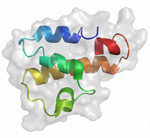PHILADELPHIA – Researchers at the University of Pennsylvania School of Medicine have found that some proteins of the immune system can promote tumor growth. Investigators found that instead of fighting tumors, the protein C5a, which is produced during an immune response to a developing tumor, helps tumors build molecular shields against T-cell attack. These findings appeared online this week in Nature Immunology.
 |
Model of the C5a molecule, part of the immune complement system. Credit: John D. Lambris, PhD, University of Pennsylvania School of Medicine.
Click on thumbnail
to view full-size image |
C5a is part of the complement system, one of the body’s immune defenses against pathogens. When activated, the system’s proteins rid the body of microbes and foreign cells. Many cancer treatments are aimed at boosting the immune system to kill tumors.
“Until now, everyone thought that the complement system was there to eliminate tumor cells. We found that in some conditions, the complement system can promote tumor growth, depending on the specific tumor and the specific environment in which the tumors are developing,” says John Lambris, PhD, the Dr. Ralph and Sallie Weaver Professor of Research Medicine.
However, Penn researchers found that in a mouse model, activation of the complement system in tumor tissue leads to the generation of C5a, which recruits myeloid-derived suppressor cells (MDSC) to tumors. These MDSCs block the function of CD8+ T cells, which would normally dismantle a tumor.
Researchers also found that blocking the C5a receptor on cell surfaces impairs tumor growth at the same rate of Paclitaxel, a chemotherapy drug. This discovery could lead to new cancer treatments with far fewer side effects than chemotherapy, surmise the investigators.
“Researchers are trying to introduce immune therapies and anti-tumor vaccines, but most of these vaccines fail,” says Lambris. “We show in this study a possible mechanism how to overcome this problem.” Lambris and his team are conducting studies that apply the approaches outlined in this paper to five models of cancer.
In addition to Lambris, Penn co-authors are Maciej M. Markiewski, Robert A. DeAngelis, Salome K Ricklin-Lichtsteiner, Anna Koutoulaki, Fabian Benencia (now at Ohio University), and George Coukos, as well as Craig Gerard, Children’s Hospital, Boston. The National Institutes of Health provided funding for this research.
###
PENN Medicine is a $3.6 billion enterprise dedicated to the related missions of medical education, biomedical research, and excellence in patient care. PENN Medicine consists of the University of Pennsylvania School of Medicine (founded in 1765 as the nation's first medical school) and the University of Pennsylvania Health System.
Penn's School of Medicine is currently ranked #4 in the nation in U.S.News & World Report's survey of top research-oriented medical schools; and, according to most recent data from the National Institutes of Health, received over $379 million in NIH research funds in the 2006 fiscal year. Supporting 1,700 fulltime faculty and 700 students, the School of Medicine is recognized worldwide for its superior education and training of the next generation of physician-scientists and leaders of academic medicine.
The University of Pennsylvania Health System (UPHS) includes its flagship hospital, the Hospital of the University of Pennsylvania, rated one of the nation’s top ten “Honor Roll” hospitals by U.S.News & World Report; Pennsylvania Hospital, the nation's first hospital; and Penn Presbyterian Medical Center. In addition UPHS includes a primary-care provider network; a faculty practice plan; home care, hospice, and nursing home; three multispecialty satellite facilities; as well as the Penn Medicine Rittenhouse campus, which offers comprehensive inpatient rehabilitation facilities and outpatient services in multiple specialties.
Penn Medicine is one of the world’s leading academic medical centers, dedicated to the related missions of medical education, biomedical research, excellence in patient care, and community service. The organization consists of the University of Pennsylvania Health System and Penn’s Raymond and Ruth Perelman School of Medicine, founded in 1765 as the nation’s first medical school.
The Perelman School of Medicine is consistently among the nation's top recipients of funding from the National Institutes of Health, with $550 million awarded in the 2022 fiscal year. Home to a proud history of “firsts” in medicine, Penn Medicine teams have pioneered discoveries and innovations that have shaped modern medicine, including recent breakthroughs such as CAR T cell therapy for cancer and the mRNA technology used in COVID-19 vaccines.
The University of Pennsylvania Health System’s patient care facilities stretch from the Susquehanna River in Pennsylvania to the New Jersey shore. These include the Hospital of the University of Pennsylvania, Penn Presbyterian Medical Center, Chester County Hospital, Lancaster General Health, Penn Medicine Princeton Health, and Pennsylvania Hospital—the nation’s first hospital, founded in 1751. Additional facilities and enterprises include Good Shepherd Penn Partners, Penn Medicine at Home, Lancaster Behavioral Health Hospital, and Princeton House Behavioral Health, among others.
Penn Medicine is an $11.1 billion enterprise powered by more than 49,000 talented faculty and staff.